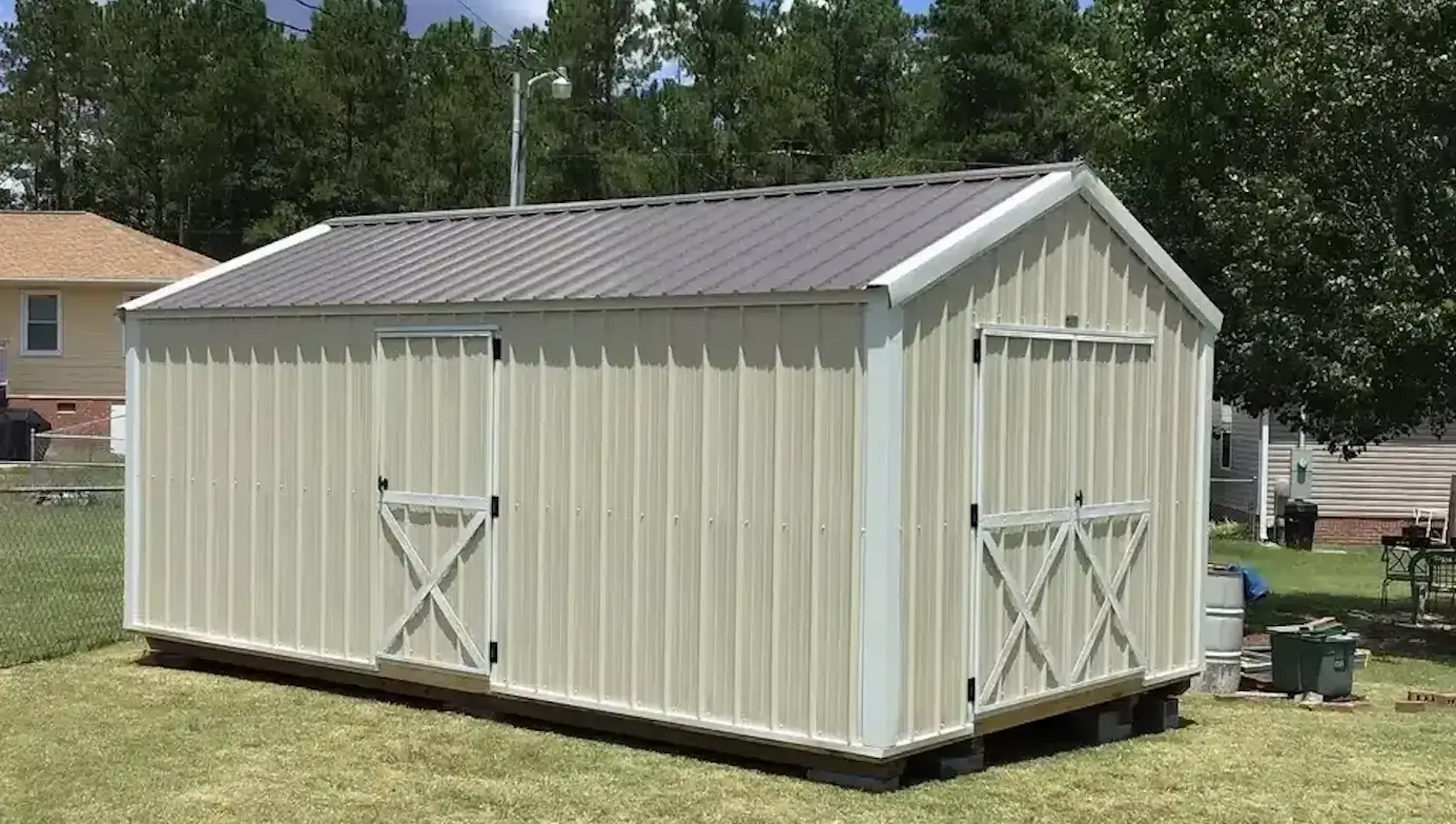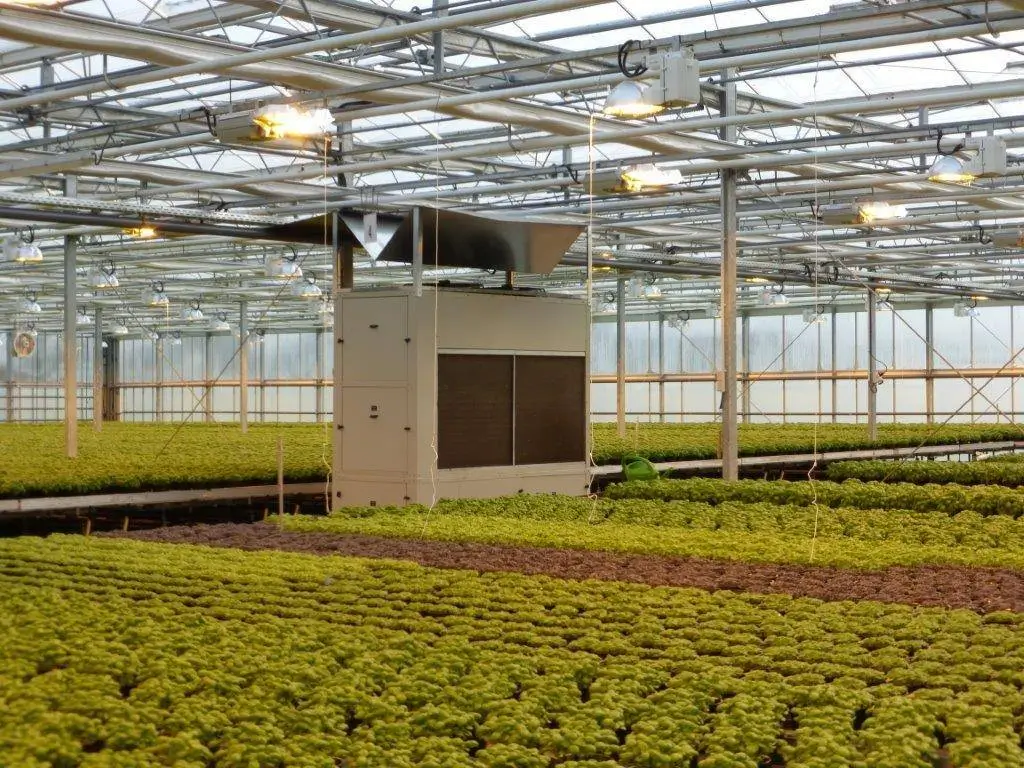- Commercial dehumidifiers help prevent mold, equipment damage, and product spoilage by maintaining optimal humidity levels in various environments.
- Selecting the right dehumidifier requires considering factors like capacity, airflow, drainage options, and energy efficiency to ensure effective moisture control in large spaces.
- Regular maintenance, such as cleaning filters and inspecting drainage systems, is essential for ensuring the long-term efficiency and lifespan of a commercial dehumidifier.
High humidity is an ideal environment for mold to grow, damaging goods, posing health risks, and even becoming expensive to rectify. It also harms equipment, leading to rust, corrosion or other issues, especially for those in industries that have sensitive machines. Also, too much moisture can be detrimental to the quality of goods, particularly when it comes to food storage, pharmaceuticals, and electronics as moisture may cause them to spoil or deteriorate.
Following product and equipment problems, excessive humidity results in an uncomfortably dangerous working environment for employees. Workers in these environments may have problems with their health, such as dehydration or heat exhaustion which may cause accidents, or a drop in the speed and effectiveness of their own work. Therefore, commercial dehumidifier buying guides are crucial in order to avoid these problems to run businesses smoothly.
MEET THE EXPERT
- ■
Steve Fontaine is an expert in indoor air quality and dehumidification, with over 25 years of experience in air quality solutions, specializing in humidity control and air quality consulting for commercial and residential sectors.
- ■
Charles Nehme is a seasoned HVAC consultant with over 30 years of global experience, specializing in innovative dehumidification and climate control solutions for industries such as data centers, cleanrooms, and pharmaceutical facilities.
Understanding Commercial Dehumidifiers
Commercial dehumidifiers are units that are specially designed to manage and eliminate the surplus moisture from a much larger or more complicated area than residential dehumidifiers. These systems are designed to efficiently manage larger capacity levels and are suitable for spaces that demand constant and aggressive moisture control. A commercial dehumidifier works by reducing the relative humidity inside an area to a degree where moisture-related issues are minimized.
Commercial Dehumidifiers vs Residential Models
Feature | Commercial Dehumidifiers | Residential Dehumidifiers |
Capacity and Size | Extracts 30-250 pints/day, designed for large spaces. | Extracts 20-50 pints/day, suitable for smaller spaces. |
Durability | Built for continuous, heavy-duty use with industrial components. | Made for occasional use with lighter materials. |
Energy Efficiency | More energy-efficient for long-term, constant operation. | Less energy-efficient, designed for intermittent use. |
Advanced Features | Includes programmable humidistats, remote monitoring, and continuous drainage. | Basic controls, lacking advanced industrial features. |
Applications of Commercial Dehumidifiers
Business dehumidifiers are used in dozens of industries and commercial settings in which sensitivity is the key to success.
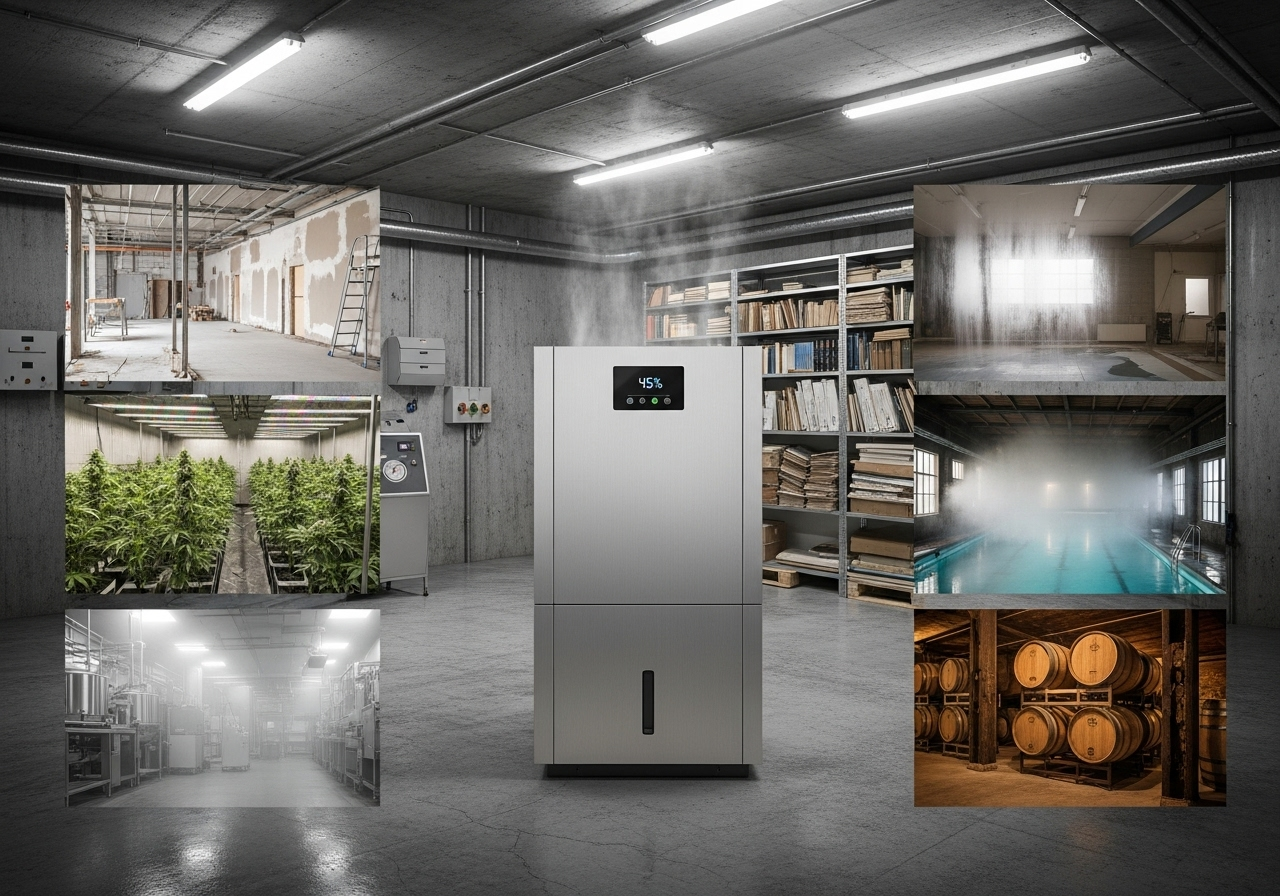
1. Warehouses
- Warehouses, and particularly warehouses storing perishable items, electronics, or chemicals, require continuous humidity management so as to avoid product spoilage, mold growth, and equipment corrosion.
- A commercial dehumidifier supports the desirable humidity measurements of wares stored within warehouses, keeping their shelf life sustainability and end product quality.
2. Grow Rooms
- Grow facilities are delicate with humidity being kept in close control to ensure good plant growth. Too much humidity can cause mold, mildew or other fungal diseases that can destroy crops.
- Commercial dehumidification provides the correct climate for the plants, as well as helps encourage faster drying times of harvested crops.
3. Basements and Crawl Spaces
- Basements or crawl spaces commonly have very high humidity levels, and poor ventilation is even worse when these spaces are situated below ground level, leading to dampness, mold and wood decay.
- In commercial facilities, dehumidifiers for these areas help guard against mold and mildew, protect stored items from spoiling, and leave users with cleaner air and a more tolerable living or working condition.
4. Indoor Pools and Spas
- Humidity from indoor swimming pools and spas can result in condensation on walls, ceilings and equipment corroding surfaces and forming mildew and mold.
- A dehumidifier for commercial use is designed to keep the humidity in public pools and spas in check, to inhibit condensation and ensure the building's structural soundness for a longer period.
5. Food Storage and Processing Facilities
- Regulating humidity is crucial for keeping the quality and safety of any food product in food storage and food processing. Excessive moisture can lead to bacterial growth, spoilage and mould.
- Commercial dehumidifier for mold prevention not only helps to keep the environment conducive for storage of food, but serves as food saving solution while reducing the risks of spoilage, and keeping the user in line with the law.
6. Museums and Archival Spaces
- Museums, archives, and libraries possess collections that contain artifacts sensitive to humidity changes, such as ancient manuscripts, paintings, artifacts, and books.
- By regulating humidity levels, these units protect other valuable materials and supplies including books, paperwork, furniture, manufacturing equipment, and much more and prevent them from becoming damaged or destroyed by mold, mildew, and condensation.
Types of Commercial Dehumidifiers
When choosing a commercial dehumidifier, consider the type of dehumidifiers that are available and the type that will work best for the facility and operational needs.
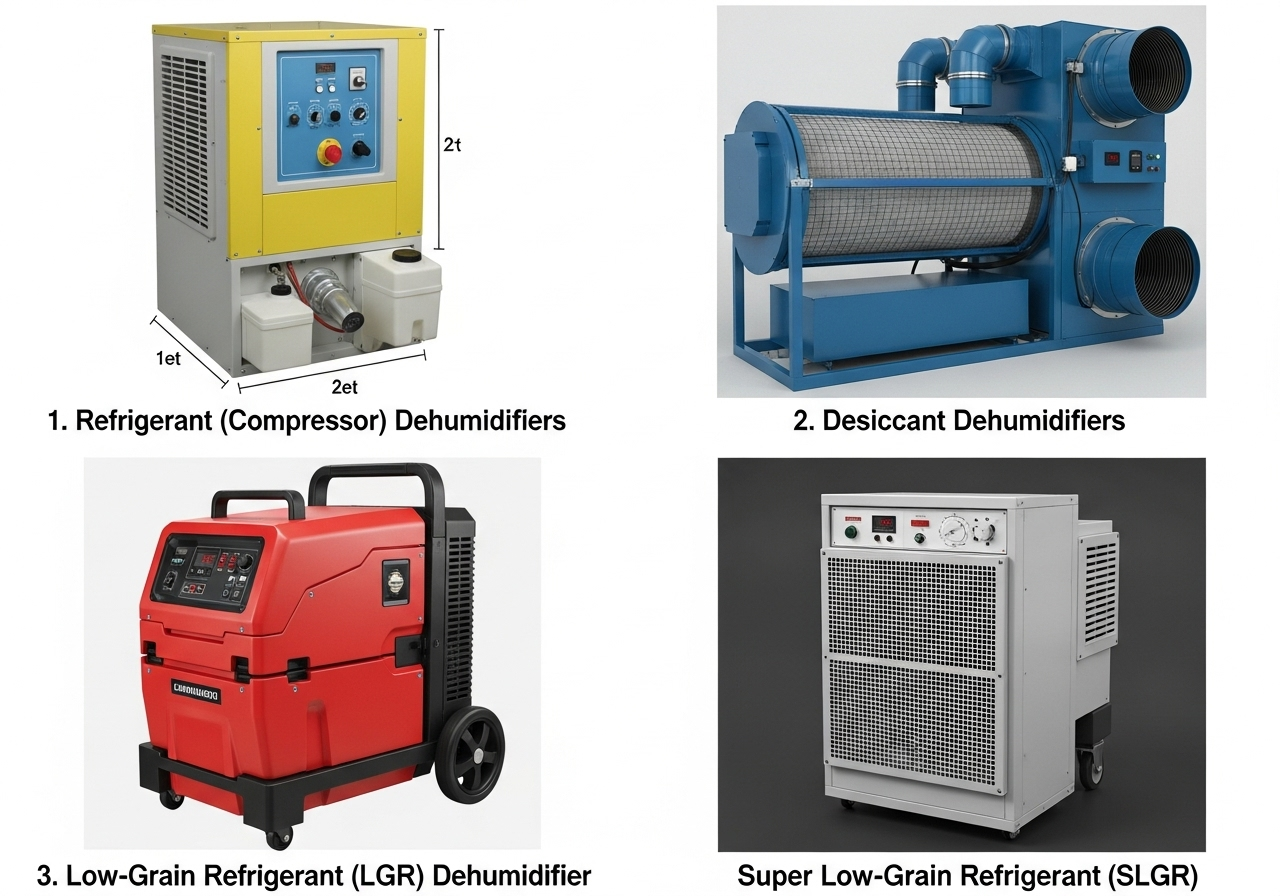
1. Refrigerant (Compressor) Dehumidifiers
Most commercial applications use refrigerant dehumidifiers in moderate temperature conditions.
- Refrigerant models cool the air by means of a compressor and evaporator coils. As air cools, the moisture will condense as water and be collected for drainage.
- It's really not that different from how an air-conditioner works except that it performs moisture removal instead of just cooling.
Recommended for humid spaces in warmer climates, where the temperature is fairly consistent throughout the year (Warehouses, manufacturing plants, or general storage).
2. Desiccant Dehumidifiers
Desiccant dehumidifiers operate on the principle of adsorption, i.e., they use hygroscopic materials (desiccants) to remove vapor from air, without the use of refrigerants.
- These dehumidifiers move the air over a revolving coated wheel which is exposed to the air and the moisture absorbing desiccant (silica gel) draws the moisture from the air. If the air comes in, the water is drawn out in the process.
- The wheel is thereafter heated through with the recovered moisture being expelled and discarded.
Perfect for cooler or low humidity environments, including cold dry or dry storage warehouses that need dehumidification in spring and fall ( cold dry storage, pharmaceutical storage).
3. Low-Grain Refrigerant (LGR) Dehumidifiers
Low-Grain Refrigerant (LGR) dehumidifiers are high-quality refrigerant models that take refrigerant technology to the next level to produce ultra-low humidity levels.
- Unlike standard refrigerant models, LGR dehumidifiers work with a two-stage refrigeration system that cools the air to temperatures that are far below the dew point.
- This allows them to dry the less-wet air more easily.
Effective in hot as well as cold areas, it can be used in various applications like warehouses, commercial kitchens, and pharmaceutical areas.
4. Super Low-Grain Refrigerant (SLGR) Dehumidifiers
SLGR dehumidifiers are the cutting-edge solution for ultra-low humidity control in specialized applications. These systems are usually engineered to reach very low humidity levels, which are usually required in highly sensitive commercial environments.
- SLGR units are even more advanced than LGR dehumidifiers. They utilize complex refrigeration apparatuses with energy recovery systems to dry out the air even more than LGR dehumidifiers.
Ideal for specialized applications such as high-tech, manufacturing, laboratory, and data center areas where even ultra-low humidity levels are required to safeguard materials or processes.
Top Commercial Dehumidifier Models
The following are a couple of leading models to look out for on Growcycle, created to deliver strong and rapid moisture extraction in a variety of commercial settings:
1. Quest 506 Commercial Dehumidifier
One of the most powerful dehumidifiers on the market, the Quest 506 is an amazingly efficient and reliable means of expelling excess moisture up to 506 pints per day at 80°F and 60% relative humidity (RH).
Ideal for commercial applications such as warehouses, grow rooms, repacking, and industrial spaces.
- Capacity: 506 pints per day
- Energy Efficiency: 8.1 pints per kilowatt-hour (kWh)
- Airflow: Efficient moisture removal
- Filtration: MERV-13 filter for superior air quality
- Flexibility: Can be installed overhead or placed on the floor
- Power: Low 11 amp draw
Perfect for any situation that requires high moisture control, the unit is reliable without drawing an unreasonable amount of power with its power efficient range of operation.
2. Anden A130 Industrial Dehumidifier
The Anden A130 delivers powerful performance for the most demanding growers.
Its 130-pint per day capacity is ideal for use in large grow rooms and grow warehouses.
- Capacity: 130 pints per day
- Airflow: 310 CFM for optimal performance
- Filter: MERV 11 disposable filter
- Voltage: 120V with an 8.3 amp current draw
- Warranty: 5-year warranty for reliability
- Ideal Use: Perfect for high-performance applications in controlled spaces
The Anden A130 provides powerful dehumidification with the added benefit of energy efficiency, making it a top choice for industrial spaces.
3. Drop Air X Industrial Dehumidifier
The Drop Air X industrial dehumidifier for basement and other heavy duty applications is with the maximum moisture removal capacity up to 190 PPD.
It’s ideal for larger commercial spaces such as warehouses, and high-humidity areas.
- Capacity: 190 pints per day
- Airflow: 25,000 CFM for rapid moisture removal
- Voltage: 115V with 10 amps current draw
- Display: User-friendly digital display panel
- Mobility: Heavy-duty casters for easy movement
- Size: Compact and space-saving design
The Drop Air X provides the high airflow and strong dehumidification needed in larger areas that experience daily humidity fluctuations.
4. Ideal-Air Pro Series 180 Pint Dehumidifier
The Ideal-Air Pro Series 180 Pint Dehumidifier is designed for a challenging environment. This series is powerful and packed with features such as a built in condensate pump, low temperature operation, electronic defrost, external control capabilities and the system still includes the remote humidistat.
This model is perfect for places such as warehouses and storerooms.
- Capacity: 180 pints per day
- Power: Operates on 115V with a 12.31 amp current draw
- Features: Includes an internal condensate pump and built-in defrost system
- Ideal For: Large spaces requiring consistent moisture control down to 41°F
- Design: Removable, washable filter for easy maintenance
The Ideal-Air Pro Series Ultra Sonic humidifier is the newest addition to the Pro series line of humidification and purification/controllers.
Key Features to Consider Before You Buy
When choosing a commercial dehumidifier, there are some key features that should be taken into consideration so that the user can be confident that the unit will remove moisture effectively, fit the space where it should be located and save money.
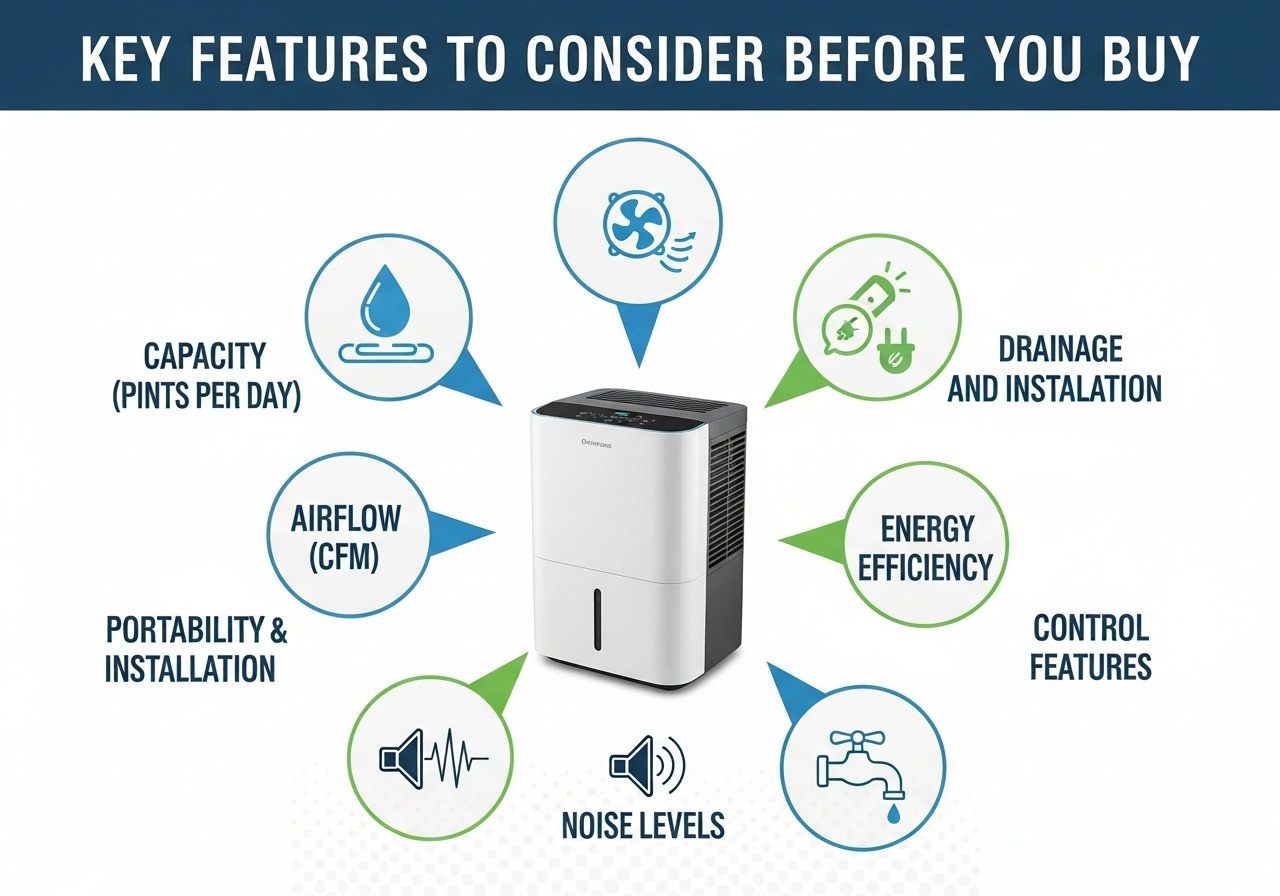
1. Capacity (Pints per Day)
A dehumidifier’s capacity is how much moisture it can remove from the air in a day. It is necessary to choose the correct capacity to effectively control humidity.
- Small Spaces (e.g., small offices or storage areas): A dehumidifier with a capacity of 30 to 70 pints per day typically suffices.
- Medium Spaces (e.g., larger offices or grow rooms): The user will need a dehumidifier with the capability of 70-150 pints per day.
- Large Spaces (e.g., large warehouses or basements): For large spaces, such as basements or warehouses, a dehumidifier with a capacity of 150 pints per day or more is needed to efficiently control moisture.
2. Airflow (CFM)
Airflow (CFM), or Cubic Feet per Minute, measures how much air the dehumidifier can move in a specific time. Proper ventilation is necessary to ensure that the removal of moisture is effective.
- A higher CFM is necessary for large spaces or areas with high humidity, such as warehouses or grow rooms.
- Smaller rooms may only require a dehumidifier with a lower CFM.
- The layout of the space matters as well. For instance, narrow or long rooms may need more airflow to ensure all areas are adequately dehumidified.
3. Drainage Options
There are two main options for how to drain a commercial dehumidifier:
- Manual Drainage: Users have to empty the collection tank manually from time to time. This is generally appropriate for smaller areas, or where the humidity is not too high.
- Continuous Drainage with Pump: When navigating persistent damp conditions, this setup allows the unit to drain without having to empty it manually. This is particularly beneficial for people with larger homes or for those who don’t want to have to empty the unit as often.
4. Portability and Installation
Dehumidifiers come in a variety of fixed or portable configurations and have varying installation and usage considerations.
- Fixed Units: As the name implies, these types of dehumidifiers will be mounted in one place and are more of a long term solution for larger installations. They tend to be stronger and ideal for larger rooms that have more humidity.
- Portable Units: These units can be moved from room to room and are great for those in buildings with fluctuating humidity levels or who use them in small spaces.
5. Energy Efficiency
The concept of energy efficiency has a significant impact on the long term cost and environmental considerations.
- ENERGY STAR Certification: With a high Energy Star rating, the unit is more environmentally friendly and also helps save on energy bills.
- Long-Term Savings: Energy-efficient models may be more expensive initially but they save electricity and thus save money in the long term, yielding a greater return on investment.
6. Noise Levels
For areas where noise sensitivity is a consideration, the dehumidifier’s noise level is a factor.
- There are a few dehumidifiers that are created to run extra quietly, which is great if you have employees, customers or sensitive products in the area.
- They are ideal for spaces that are too wet and do not need to hear the machines when they are operating. These units have special features that reduce the noise created by the units (like sound reducing casings or low noise compressors).
7. Control Features
Advanced controls make today’s dehumidifiers easy and convenient to operate.
- Built-in Humidistats: Humidistats enable the unit to regulate and maintain the desired level of humidity by cycling the unit on and off to continue to keep the desired humidity level once it is reached.
- Timers and Smart Controls: Most dehumidifiers include programmable timers and smart controls that allow you to monitor and control their operation remotely, likely via a smartphone app.
ℹ
Maintenance and Longevity
If you want a commercial dehumidifier to last and work as good as new, it needs to be maintained.
- Cleaning Filters: Clean or replace the dehumidifier’s air filters often to prevent clogs and maintain high airflow efficiency. Dirty filters lower performance and increase energy use.
- Checking Drainage Systems: Inspect the drainage system (manual or continuous) to ensure it’s free from debris. Blockages can cause water backup and damage the system.
- Inspecting Coils: Clean evaporator and condenser coils regularly to remove dust and debris. Dirty coils can cause overheating and reduce efficiency.
- Increased Noise: Sudden noise may indicate wear on parts like fans or compressors.
- Reduced Efficiency: If the unit removes less moisture, there could be an issue with internal components or filters.
- Frequent Shutdowns: If it shuts off often or fails to reach the set humidity, call a professional for inspection.
- Regular Cleaning and Maintenance: Keep the unit clean and blockage-free to reduce system strain.
- Proper Storage: Store in a cool, dry place when not in use for long periods to prevent corrosion.
- Scheduled Servicing: Professional servicing helps catch problems early and extends the unit’s lifespan.
Summary
Commercial dehumidifiers are used to remove humidity and excess moisture in environments such as warehouses, grow rooms, factories, and storage facilities. When choosing a commercial dehumidifier, users shouldn’t forget to bear in mind the essential criteria such as capacity, airflow, drainage options, and energy efficiency. Commercial models are built for heavy use in big spaces and are made to operate non-stop, unlike residential appliances intended for low-use applications in smaller areas.
If in need of high quality dehumidifiers, Growcycle features a selection of some of the best models in the industry to cater to various commercial requirements. They offer sound advice and quality products to businesses that want to keep the right humidity level and ensure they have proper coverage.
Disclaimer: This material is for informational purposes only and should not be relied on for legal, medical, financial, or any other form of professional advice.
